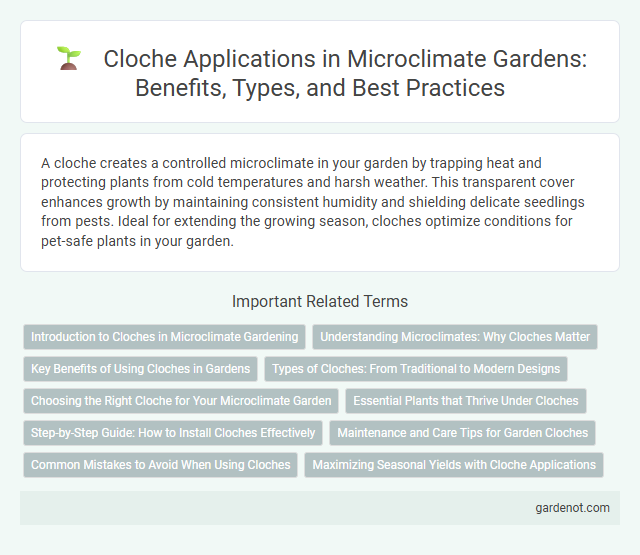A cloche creates a controlled microclimate in your garden by trapping heat and protecting plants from cold temperatures and harsh weather. This transparent cover enhances growth by maintaining consistent humidity and shielding delicate seedlings from pests. Ideal for extending the growing season, cloches optimize conditions for pet-safe plants in your garden.
Introduction to Cloches in Microclimate Gardening
Cloches serve as essential tools in microclimate gardening by creating a controlled, warm environment that protects delicate plants from harsh weather conditions and extends the growing season. Typically made from glass or plastic, cloches function as mini-greenhouses, trapping heat and moisture to enhance plant growth in small, confined spaces. Their strategic use helps gardeners optimize microclimate zones, improving plant health and increasing yields in variable climates.
Understanding Microclimates: Why Cloches Matter
Cloches create a protective microclimate by trapping heat and moisture, enhancing plant growth in garden zones with fluctuating temperatures or early frosts. These transparent covers amplify sunlight exposure while reducing wind impact, stabilizing delicate seedlings and extending the growing season. Using cloches effectively supports sustainable gardening by optimizing temperature regulation and moisture retention within localized plant environments.
Key Benefits of Using Cloches in Gardens
Cloches create a warm, humid microenvironment that accelerates plant growth and extends the growing season by protecting seedlings from frost and cold temperatures. They shield delicate plants from pests and harsh weather, reducing the need for chemical treatments and increasing crop yield. By maintaining consistent moisture levels, cloches promote healthier root development and reduce water stress in garden plants.
Types of Cloches: From Traditional to Modern Designs
Cloches, designed to protect plants from harsh weather and extend the growing season, come in various types ranging from traditional glass domes to modern plastic and fabric variants. Traditional glass cloches offer excellent insulation and light transmission, making them ideal for delicate seedlings and early spring planting. Modern designs include flexible, lightweight plastic cloches and breathable fabric options that provide targeted protection while ensuring airflow, catering to diverse garden microclimate needs.
Choosing the Right Cloche for Your Microclimate Garden
Selecting the right cloche for your microclimate garden depends on factors such as temperature regulation, humidity control, and plant size. Glass cloches provide excellent insulation and durability, ideal for frost-sensitive plants, while plastic or polycarbonate options offer lightweight and budget-friendly protection. Ensure the cloche fits securely over your plants to maintain consistent warmth and shield them from harsh weather variations in your specific microclimate.
Essential Plants that Thrive Under Cloches
Lettuce, spinach, and radishes are essential plants that thrive under cloches, benefiting from the warm, protected microclimate they create. Tomatoes and peppers also flourish under these mini-greenhouses, which extend the growing season by shielding plants from frost and wind. Herbs such as basil and cilantro experience accelerated growth when nurtured beneath cloches, making them ideal candidates for early spring and late fall cultivation.
Step-by-Step Guide: How to Install Cloches Effectively
To install cloches effectively in a microclimate garden, start by selecting durable, transparent materials such as glass or clear plastic that allow maximum sunlight penetration while protecting plants from frost. Position cloches over young seedlings or frost-sensitive plants, ensuring they are firmly anchored into the soil to prevent displacement by wind. Regularly monitor temperature and moisture levels inside the cloche to maintain optimal growing conditions and prevent overheating or fungal growth.
Maintenance and Care Tips for Garden Cloches
Garden cloches require regular cleaning to prevent mold and ensure optimal light penetration for healthy plant growth. Inspect cloches frequently for cracks or damage to maintain insulation and protect plants from pests and harsh weather. Proper ventilation during warmer days avoids overheating and promotes air circulation within the microclimate area.
Common Mistakes to Avoid When Using Cloches
Using cloches incorrectly can lead to poor plant growth due to overheating or inadequate ventilation, which causes moisture buildup and fungal diseases. Avoid placing cloches directly on wet soil, as this traps humidity and promotes rot, and ensure regular monitoring to prevent temperature spikes during sunny days. Choosing the wrong size or neglecting to lift cloches for air circulation can also stunt plant development and reduce the effectiveness of microclimate control in your garden.
Maximizing Seasonal Yields with Cloche Applications
Cloche applications extend growing seasons by creating a controlled microclimate that protects plants from frost and pests, effectively maximizing seasonal yields. Their transparent covers enhance sunlight capture and retain heat, accelerating plant growth while reducing water loss through evaporation. Using cloches enables gardeners to cultivate a wider variety of crops earlier in spring and later into fall, optimizing space and productivity in microclimate gardens.
Cloche Infographic

 gardenot.com
gardenot.com